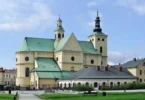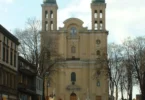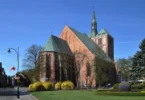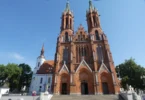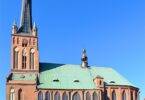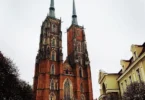Introduction
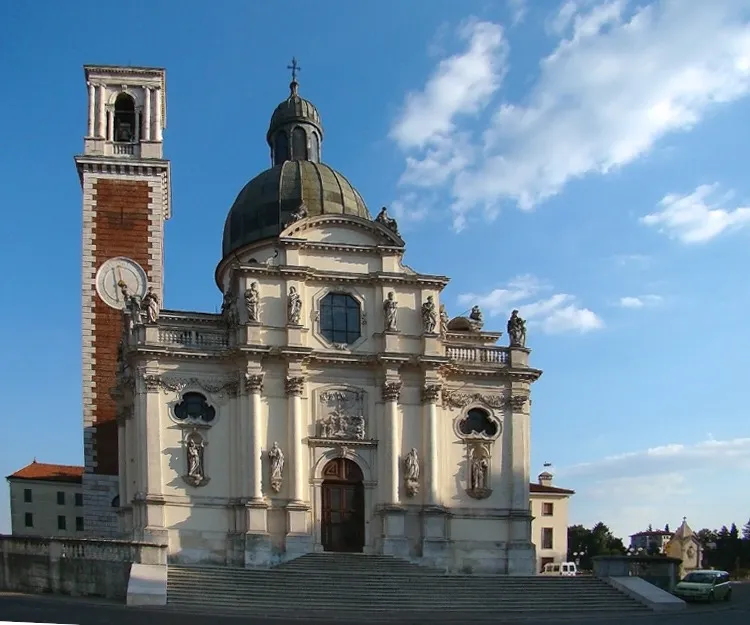
The sanctuary of the Madonna di Monte Berico is a Catholic place of worship in Vicenza , located in124 m above sea level , on the top of the hill of the same name that dominates the city. It is the result of the integration of two churches : the first one from the fifteenth century in Gothic style , the second one, from the second half of the seventeenth century , is a basilica in Baroque style . In May 1904 Pope Pius X elevated it to the rank of minor basilica .
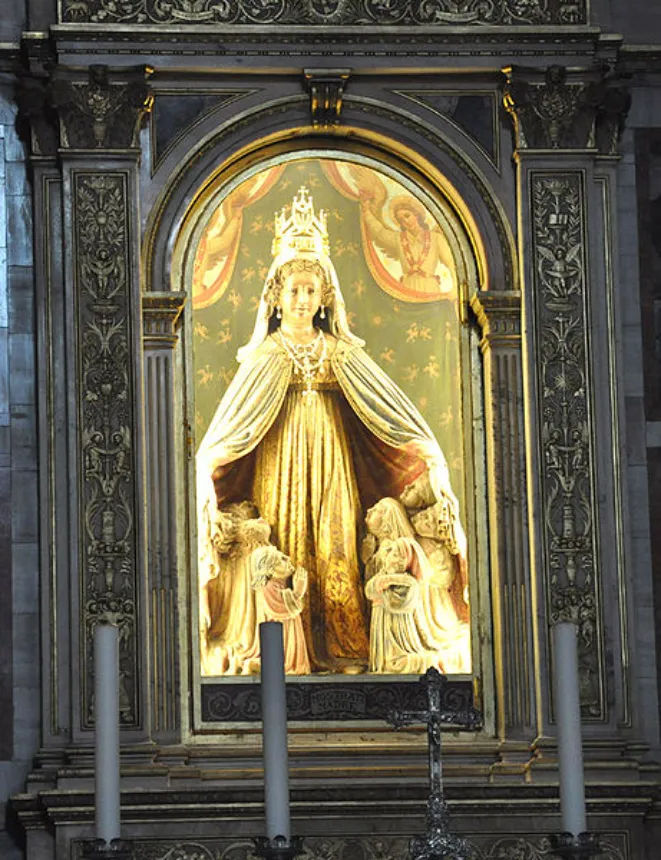
Modern era : The apparitions of the Madonna
Engraving by Cristoforo Rosio, 1653 , representing the Scalette arch , the mountain, the church and the apparition of the Madonna.
The construction of the first church is, according to tradition, linked to two apparitions of the Madonna which a peasant woman from Sovizzo named Vincenza Pasini is said to have witnessed , respectively in 1426 and 1428 , years devastated by a serious plague epidemic ; in these apparitions the Madonna is said to have asked for the construction of a church dedicated to her. In fact, the chronicles of the time agree in reporting that, after the Municipality accepted this invitation – a small chapel built in just three months – that episode of plague ceased. The altar with the image of the Madonna was placed against the wall, at the point where it was believed the apparitions had occurred and where the sacred image is still venerated today.
The main source on which the historiography is based is the Trial of the apparitions of the Virgin at Monte Berico , edited by the jurist Giovanni da Porto in 1430-1431. This notarial deed had a critical edition in 1991, where the facsimile of the manuscript is reported, now kept at the Bertoliana Civic Library .
Some authors highlight the moment of crisis that the municipality of Vicenza was going through, which had lost all political autonomy, first under the rule of the Scaligeri and the Visconti, then with the dedication to the Republic of Venice , which occurred in 1404. The two mariophanies at Monte Berico and the subsequent foundation of the sanctuary would have contributed to strengthening the civic identity which had been profoundly shaken by the changes of ownership.
The First Gothic Church and Its Early History
The first Gothic church, initially named Sancta Maria de Gratia, was originally managed by the Order of Saint Bridget. However, in 1435, Pope Eugene IV ordered the friars to leave the church and adjoining convent. Management was transferred to the congregation of the Observance of the Servants of Mary, led by Brother Antonio da Bitetto, who arrived from the Sant’Alessandro convent in Brescia.
By the mid-15th century, the Servites had completed significant additions to the convent, including a cloister, guesthouse, infirmary, and bell tower. Despite the challenges posed by the steep terrain of the Valletta del Silenzio to the south, these projects were successfully completed. From the outset, the sanctuary became a central focus of religious life in Vicenza. In 1529, the city council established an annual solemn procession on August 25. Devotions to the Virgin of Monte Berico flourished, evidenced by rediscovered litanies filled with invocations and laments that reflected the hardships of the era.
The original church was expanded eastward, with the main façade opened in this direction. Around 1480, architect Lorenzo da Bologna designed a replacement for the old choir, adding chapels funded by noble families. To support the work, Bishop Giovanni Battista Zeno granted indulgences to those who contributed alms in 1476. By 1480, the sacristy and main chapel with a choir, furnished with inlaid stalls, were completed. Subsequent additions included altars and refinements to the structure.
In 1562, Andrea Palladio proposed a modern central-plan design for the sanctuary, but this plan was abandoned. Instead, in 1578-79, Palladio built a classical square addition on the north side of the Gothic church to provide more space for pilgrims. This addition replaced the cramped area in front of the altar of the Virgin under the third arch.
During the plague of 1630, the city council vowed to the Virgin of Monte Berico for divine mercy to protect the city. Following the plague, the decision was made to enlarge the church. Between 1688 and 1703, the Palladian addition was removed, and a larger structure was built. Over the century, further enhancements included sculptural decorations, new altars, and a redesign of the steps on the northern façade.
Despite their prestige, the friars of Monte Berico faced suppression under Napoleonic law in 1810. Some became secular priests, and part of the convent was sold to state property management during the French Empire. Under the Austrian Empire, religious life at the sanctuary revived, culminating in the imperial decree of 1835, which reestablished the convent.
Notable 19th-century changes included the construction of three new lateral steps in 1817 by Giacomo Verda and a new bell tower by Antonio Piovene, which replaced the 15th-century tower and destroyed part of the sacristy. The Gothic church’s west façade was restored in 1860 in a neo-Gothic style by Giovanni Miglioranza. In 1904, Pope Pius X elevated the sanctuary to the rank of minor basilica.
The 20th century saw further additions, including the construction of the modern Penitentiary (1971–1972) near the bell tower. Since 1978, the Madonna of Monte Berico has been the patron saint of Vicenza and its diocese.
Architecture of Sanctuary of the Madonna of Monte Berico, Vicenza, Italy
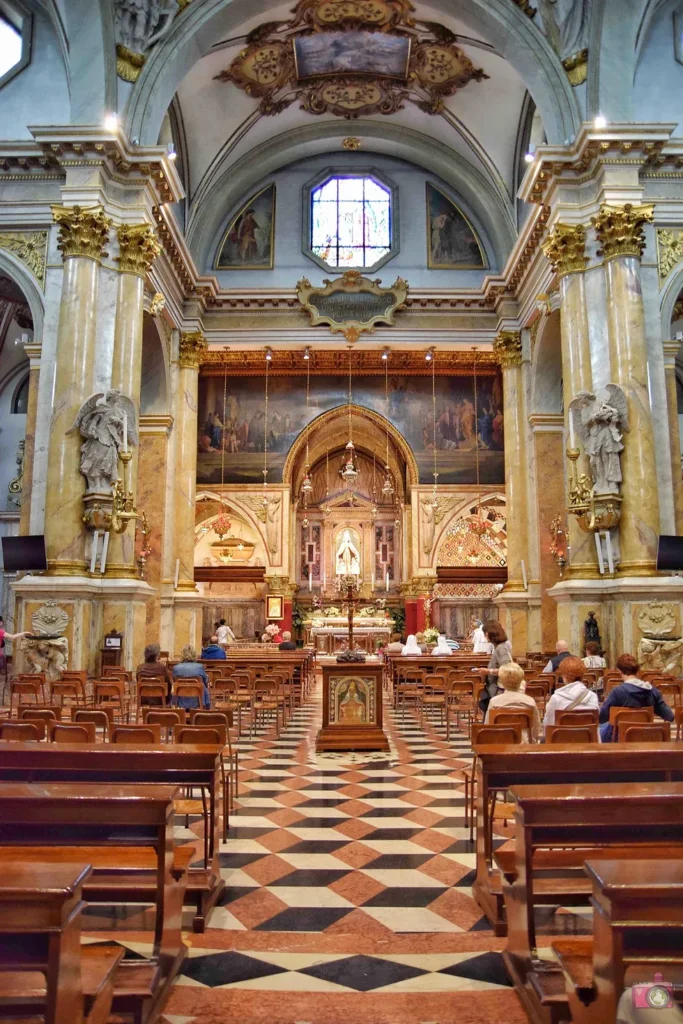
Architect : Andrea Palladio
Architectural Style : Baroque architecture
Facade
The sculptures on the facades are the work of Orazio Marinali and his workshop, of Francesco Cabianca and of Giacomo Cassetti. They represent saints and allegories of virtues .
On the facade towards the porticoes (eastern elevation) in the frame of the lunette stand out the statues of Faith and Hope; the upper register features statues of saints particularly venerated in Vicenza (including the doctor Leonzio martyred in 307 , Carpoforo and Gaetano Thiene ) and saints of tradition (including Saint Anthony of Padua and Mary Magdalene ); in the lower register are placed those of Saint Sebastian , Saint Vincent , Saint Rocco and Saint Philip Benizi . Above the portal is a depiction of the Virgin appearing to Vincenza Pasini , a work by Orazio Marinali .
The sculptural groups above the portal of the northern facade ( Vincenza Pasini in front of the deputies of Vicenza ) and above the portal of the western facade ( Laying of the first stone of the votive church ) are also by this artist. On the northern facade at the top Temperance and Justice , in the centre statues of Prophets , at the bottom Saint Andrew , Saint Peter , Saint Paul , Saint Matthew. On the western facade at the top Allegories of virtues , in the centre Heroines of the Old Testament , at the bottom Saint Bartholomew , Saint John the Evangelist , Saint Charles Borromeo and Saint Mark.
Cloister
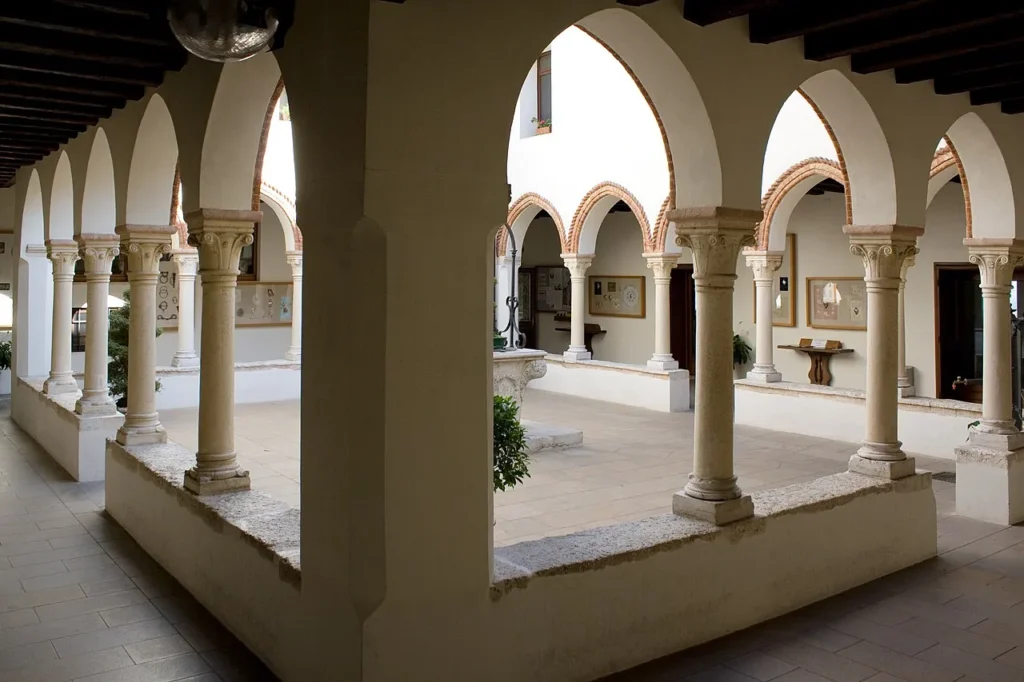
The small Gothic cloister of the basilica, built in 1429 , features beautiful pointed arches decorated with terracotta frames on stone columns, and a well from 1611.
From it you can access the ancient refectory of the friars, which contains some works of art. Among them the Supper of St. Gregory the Great by Paolo Veronese ( 1572 ). It takes place in a grandiose and classicizing loggia with columns with composite capitals and a majestic architectural background: it is a scenography that recalls the architecture of Palladio . At the center of a long table stands Gregory the Great , to whose right is Jesus dressed as a pilgrim who reveals himself to the spiritual gaze of the pontiff. Around him are twelve guests from various countries of the world, served by waiters dressed in Renaissance clothes. At the bottom left is a monkey in chains, at the bottom right a dog. In religious symbolism the dog represents fidelity (here, fidelity to the Church , to Jesus Christ ), the monkey represents disorder (it is no coincidence that it is kept in chains).
The canvas was cut into 32 pieces by Austrian soldiers on 10 June 1848 and then restored by order of Emperor Franz Joseph . In the same room there are two paintings by Alessandro Maganza : the Virgin with the four Evangelists and the Baptism of Christ .
Interior
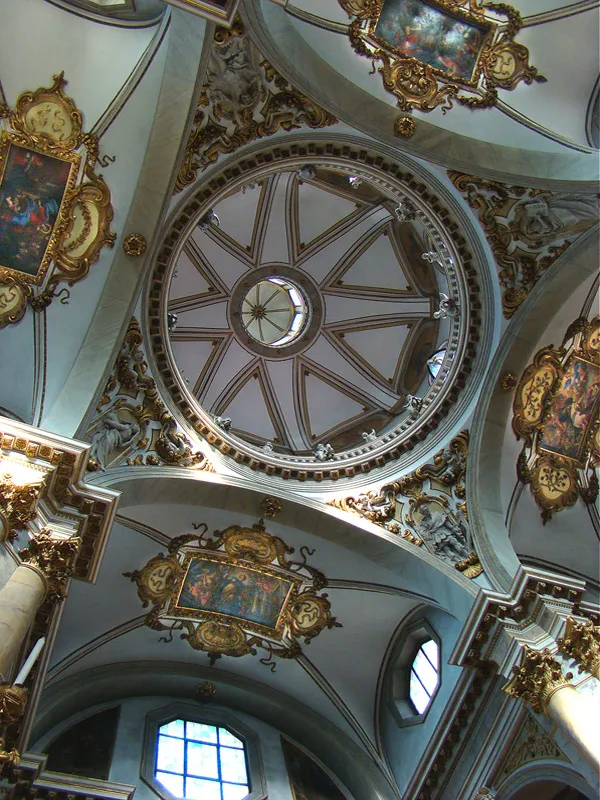
The interior of the Basilica of Monte Berico is adorned with numerous artistic treasures. Notable works include The Virgin with the Four Evangelists and The Baptism of Christ by Alessandro Maganza, as well as Bartolomeo Montagna’s Pietà, an evocative example of vesperbild. This early 16th-century masterpiece combines naturalistic elements with religious symbolism, featuring an apple (representing original sin and redemption), a butterfly (symbolizing resurrection and the soul), and a columbine plant (signifying Christ’s Passion and the Virgin Mary’s pain). The light and dramatic composition emphasize the grief of the figures, while the cold illumination reflects Nordic and Ferrarese influences. Other highlights include Giulio Carpioni’s 17th-century canvas, commissioned by the Vicenza Order of Merchants, depicting the Madonna’s appearance to Mayor Francesco Grimani as an allegory of the city. The interior also houses works by Palma il Giovane, François-Guillaume Ménageot, and Pietro Gagliardi, alongside stunning stained glass windows and richly inlaid 15th-century choir stalls.
The central focus of devotion is the statue of the Madonna, crafted by Nicolò da Venezia in the 15th century from Berici Hills stone. Adorned with a crown and jewels, the statue is positioned above the modern altar within a niche framed by a painted aedicule supported by angels. Below the statue, a silver medallion illustrates the Virgin’s apparition to Vincenza Pasini, flanked by marble bas-reliefs depicting Pasini and soldiers offering thanks after World War I. Renovations for the fifth centenary of the Apparitions (1926–1928) updated the altar and its surroundings, ensuring a prominent view of the Madonna from the sanctuary’s entrance. Pilgrims often pass in procession or pause in prayer before the medallion, further enhancing the spiritual atmosphere of the Basilica.
Pipe organ
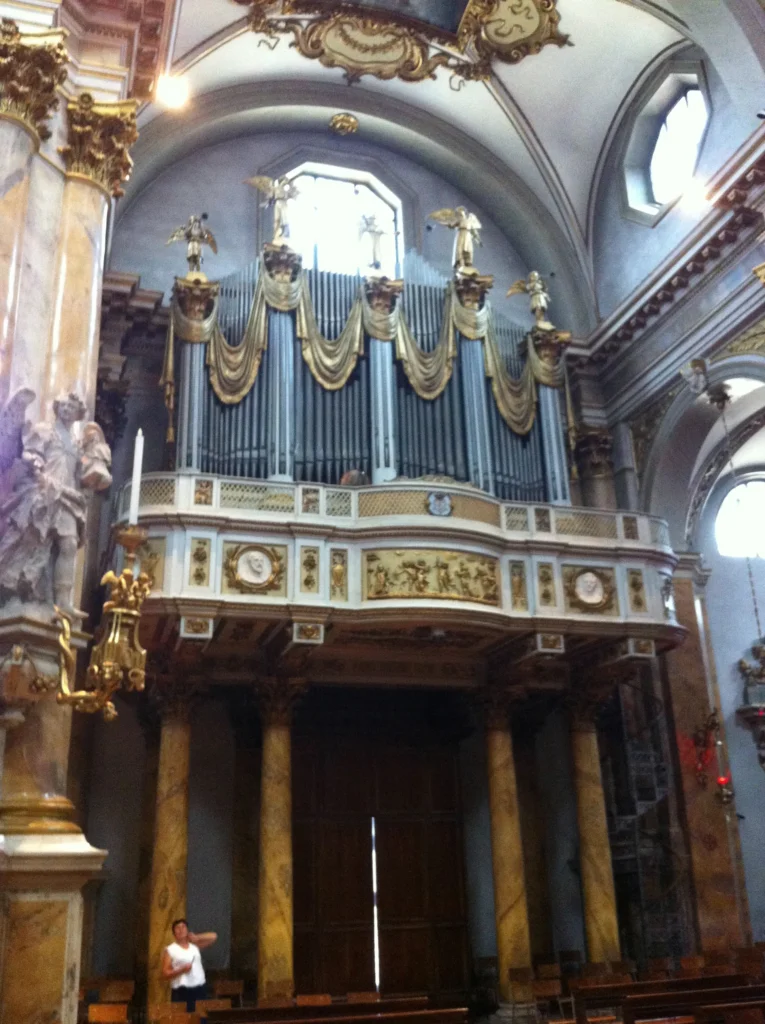
On the choir loft on the counter-façade, there is the Mascioni pipe organ opus 579, built in 1943 by recovering part of the sound material from the previous instruments by De Lorenzi and Zordan. The instrument is electric , enclosed inside a wooden case with a two-level display composed of main pipes with mitre mouthpieces ; the console has three keyboards and a pedal board.
Museum
Since its inception in 1971, the Museum of Sacred Art of Monte Berico has been located on the top floor of the east wing of the ancient convent. At this time, the overall size of the museum is 372 m 2. It is divided into six rooms of different sizes, the result of building expansions that took place over a long period of time, from the 15th to the 19th century.
The current museum layout is the result of a broad survey of all the artistic heritage held in Monte Berico, carried out during 2020. This intervention led to the creation of a new thematic itinerary, divided into sections, organically distributed in six museum rooms and capable of offering a didactically fluid narration of its whole. The exhibition itinerary involves over 500 artefacts, dating between the 14th and 21st centuries.
Feast Day
Feast Day : 8th September
The feast of the Madonna of Monte Berico is celebrated on September 8, which coincides with the Nativity of the Virgin Mary. This date is observed with great devotion and includes religious ceremonies, processions, and festivities in Vicenza, Italy.
Church Mass Timing
Monday : 7.00 AM , 8.00 AM , 9.00 AM , 10.00 AM , 11.00 AM , 4.30 PM , 5.30 PM , 6.00 PM
Tuesday : 7.00 AM , 8.00 AM , 9.00 AM , 10.00 AM , 11.00 AM , 4.30 PM , 5.30 PM , 6.00 PM
Wednesday : 7.00 AM , 8.00 AM , 9.00 AM , 10.00 AM , 11.00 AM , 4.30 PM , 5.30 PM , 6.00 PM
Thursday : 7.00 AM , 8.00 AM , 9.00 AM , 10.00 AM , 11.00 AM , 4.30 PM , 5.30 PM , 6.00 PM
Friday : 7.00 AM , 8.00 AM , 9.00 AM , 10.00 AM , 11.00 AM , 4.30 PM , 5.30 PM , 6.00 PM
Saturday : 5:00 PM , 6:00 PM
Sunday : 8:00 AM , 6:00 PM
Church Opening Time:
Monday : 7:00 am – 12:30 pm, 2:30 pm – 6:00 pm
Tuesday : 7:00 am – 12:30 pm, 2:30 pm – 6:00 pm
Wednesday : 7:00 am – 12:30 pm, 2:30 pm – 6:00 pm
Thursday : 7:00 am – 12:30 pm, 2:30 pm – 6:00 pm
Friday : 7:00 am – 12:30 pm, 2:30 pm – 6:00 pm
Saturday : 7:00 am – 12:30 pm, 2:30 pm – 6:00 pm
Sunday : 7:00 am – 6:00 pm
Contact Info
Address:
Viale Dieci Giugno, 87, 36100 Vicenza VI, Italy
Phone : +390444559411
Accommodations
Connectivities
Airway
Venice Treviso (TSF) Airport to Sanctuary of the Madonna of Monte Berico, Vicenzal, Italy distance between 1 hr (84.7 km) via A4/E70.
Railway
Vicenza railway station to Sanctuary of the Madonna of Monte Berico, Vicenzal, Italy distance between 4 min (2.1 km) via Viale Dante Alighieri.


